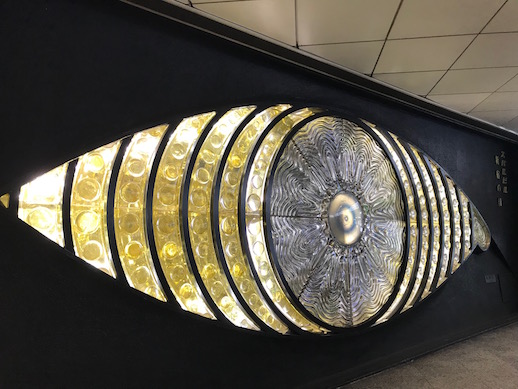The Eye of Shinjuku

Why is this artwork an eye shape? Artist Yoshiko Miyashita has said the reason is that “Shinjuku is a monster that includes the youthfulness and strength of modern Japan. To express these ideas, an eye that looks at everything in the modern world, such as the flow of time and the movement of thought, is the best.”
This public work in Shinjuku Station is called “Eye of Shinjuku” and was created by Miyashita in 1969. Miyashita is from Kagoshima Prefecture but was born in China. She is a sculptor, but does not belong to a group and is active in various places. Having lived in Paris for 17 years since 1977, she is active not only in Japan, but also overseas in places including Italy as well as France. In addition to sculptures, she produces paintings and reliefs. She also produces a lot of public art, but her best known artwork in Japan is the “Eye of Shinjuku.”
This artwork is installed on a wall of the Shinjuku Station West Exit Underground Plaza. Since it was produced in 1969, it has gained attention as an immutable symbol and appeared in many movies and in the media. It is an eye-shaped acrylic object that stands three meters high and ten meters wide. It is illuminated from behind the pupil and inside inner corner of the eye, and it shines in various colors while rotating slowly. On the whole, it is colorful, with the white of the eye shining yellow and the central pupil shining blue or green. In addition, the central pupil has a wave-like pattern. The inner corner of the eye is also expressed, and from that position it is probably the right eye. When I saw this artwork for the first time, I was reminded of a kaleidoscope. In particular, the color changes while the pupil slowly rotates, so I felt it was similar to how a kaleidoscope pattern changes.
This artwork has both positive and negative points. The positive points are that the shape is unique and it is not an unpleasant shape or color scheme. Also, I think that it is good that there is movement and that it leaves an impression on viewers, which might lead people to become interested in art. The negative point is that this artwork is a subject of urban legends due to its slightly creepy look.
As mentioned above, “Eye of Shinjuku” has appeared in various media due to its visual impact. For example, Daijiro Morohoshi’s Dreaming Machine. In this manga, the “Eye of Shinjuku” is the entrance to a secret organization. This was the basis of an urban legend rumoring that there is a mysterious door near the “Eye of Shinjuku” which leads to a secret room. Also, Shinjuku’s underground passages are in fact quite complicated, so I think this added credibility to the legend. In June 2019, an incident occurred where a man broke part of the cornea of the Eye. His motivation was not clear. However, some say that it was a crime by a person who believed in urban legends. I think this incident is an example of how the artwork has had an adverse effect on people’s hearts. I think that the impact on us is greatly influenced not only by the appearance of the artwork but also by the environment in which it is placed. I feel that this artwork was intended to be a witness, looking at all the events of Shinjuku in the past and present and the history of people.
Location: Shinjuku Station West Exit Underground Plaza
Access Details:
① Exit the Shinjuku Station West Exit ticket gate.
② There is a signboard for the Tokyo Metropolitan Government and Chuo Park. Walk toward it.
③ If you walk for about 2 minutes, you can see “Eye of Shinjuku” on a wall on the right.
Kotomi Numazawa is a student of Joshibi University of Art and Design. She is studying in the concentration of Art and Culture.
Joshibi University Art Writers
Joshibi University Art Writers



